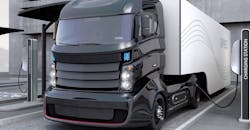NACFE issues guidance on charging infrastructure for electric trucks
The North American Council for Freight Efficiency (NACFE) released its third Guidance Report: Amping Up: Charging Infrastructure for Electric Trucks, a report detailing the multiple factors to consider in infrastructure planning for charging commercial battery electric vehicles.
The report found that although there is no one-size-fits-all solution to charging, there are common steps and considerations that any fleet looking at deploying electric vehicles needs to undertake to ensure they have a cost-effective charging strategy in place.
“Every charging installation faces a variety of variables—number of trucks to charge, local utility rate tariffs and power delivery structure, and existing site and local grid details,” says Chris Nelder of Rocky Mountain Institute. “There are no rules of thumb.”
The report provides information on infrastructure basics such as hardware, software/networking, and maintenance. It also looks at charging speeds, charger communication, and charging locations.
One area of concern when it comes to electric vehicles is grid capacity. The Guidance Report addresses that issue and suggests that utilities may have to develop new demand-management and/or storage solutions. New tariff structures may also be necessary to encourage smart charging when electricity supply is available, clean and economical.
The report offers a charging procurement roadmap that lays out, step-by-step, what fleets need to do to successfully deploy charging infrastructure.
“Planning and permitting for charging infrastructure can be a time-intensive processes,” says Mike Roeth, executive director of NACFE. “Fleets needs to start early and should use the roadmap from the Guidance Report to make sure they have included all the necessary steps.”
The report is available at nacfe.org and includes 160 references, a robust bibliography, and appendices that list charging infrastructure suppliers and utilities with electric charging programs.
NACFE is already planning additional Guidance Reports that focus on Class 7 and 8 daycabs and Class 8 long-haul electric-based vehicles.
